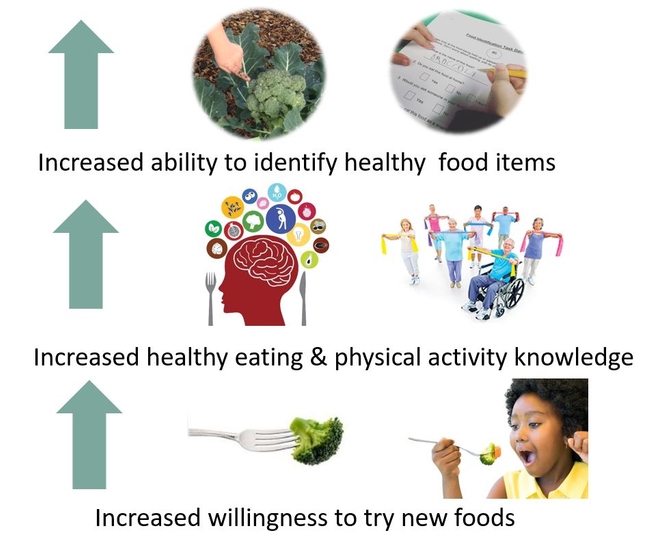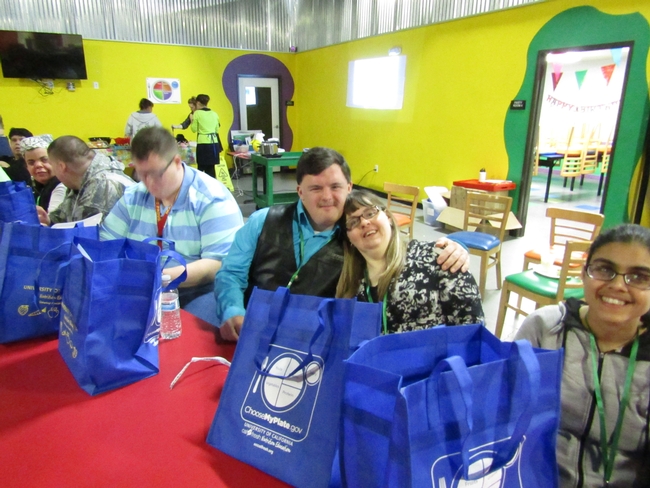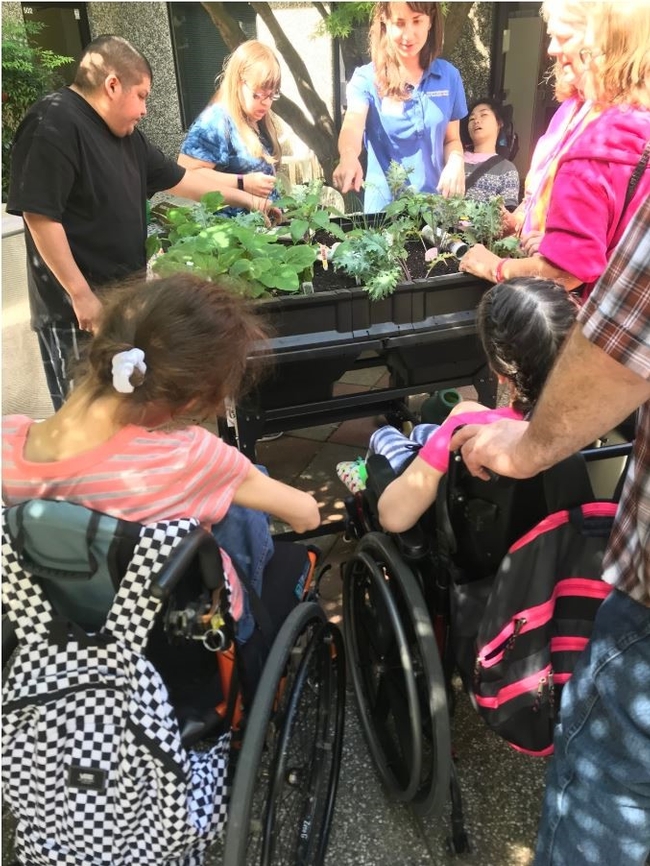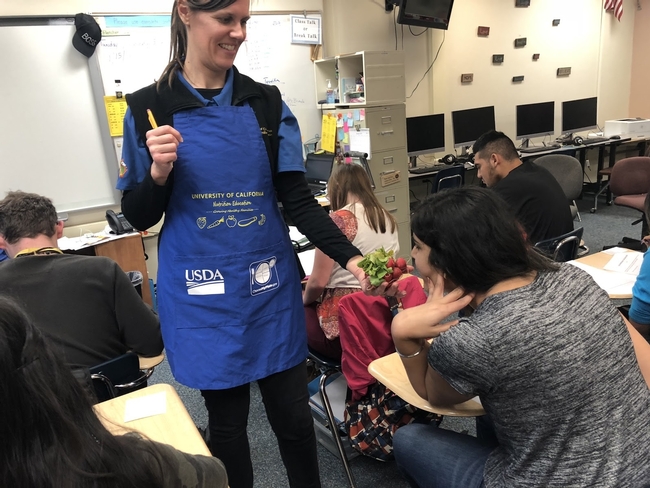Overview
Children and adolescents with physical and intellectual disabilities tend to have a higher prevalence of obesity (BMI of 30.0 or higher) compared to their non-disabled peers. According to the Centers for Disease Control, obesity rates for children (ages 2-17) with disabilities are 38% higher than for children without disabilities. This was determined from the results of the 2003-2008 National Health and Nutrition Examination Survey. Obesity and disability are health conditions that have been increasing globally and growing evidence suggests that there is a strong link between the two. Thus, emphasizing the need for effective interventions to assist individuals with disabilities in achieving and maintaining a healthy weight.
Background
In the fall of 2017, a curriculum development committee was established to develop a curriculum for individuals with physical and intellectual disabilities. The most important goal of the Learn it, Grow it, Taste it! (LIGITI) curriculum is to help learners become enthusiastic about nutrition, cooking, gardening and physical activity, and to make sure that all individuals, including those with a disability, have equal opportunities to lead a healthy lifestyle. There are 12 lessons in the curriculum and each lesson has a cooking demonstration and/or an interactive classroom activity. Activities in the curriculum aim to educate and engage learners in food preparation, food safety, nutrition, gardening, mental wellness, money management, and physical activity concepts that will contribute to their lifelong health and wellness. Cooking demonstrations were designed using an active engagement model to introduce learners to new textures, smells, and tastes, and to decrease selective eating in individuals with sensory processing abnormalities. During the 2018-19 academic year, the curriculum committee partnered with the University of California CalFresh Healthy Living Program (UC CalFresh) to pilot the curriculum in two California counties.
The Payoff: Active engagement increases willingness to try new foods for individuals with disabilities
The LIGITI curriculum was piloted in 10 classes (8 intervention, 2 control), with over 150 participants ranging from ages 6 to 65. The same curriculum was used for all ages, however, activities within the curriculum are labeled [MM] for individuals with mild to moderate disabilities, and [MS] for learners with moderate to severe disabilities. The first lesson in the curriculum engages learners in a multisensory cooking demonstration and food tasting activity which aims to help participants develop a life skill and encourages individuals with sensory processing abnormalities to try new foods. The food tasting activity in this lesson sets the precedent for all food tastings in the curriculum. Throughout the curriculum, the active engagement process is used to provide participants with opportunities to obtain and enhance their cooking skills. This is done by allowing participants the opportunity to actively participate in food preparation activities using adaptive cooking tools in a low-risk environment.
Recipes in the first few lessons are simple 2-3 ingredient recipes such as, Caramelized Broccoli, Tofu Banana Pudding, and Pineapple Frozen Yogurt. These simple recipes build up to the final recipe in lesson 12, which encourages participants to put their knowledge to the test by using adaptive cooking tools and following step-by-step instructions to prepare a Colorful Stir-Fry recipe. Throughout the curriculum, a Taste Test Tool (TTT) was used to measure behaviors such as, willingness to try new food items and willingness to eat the food again. To date, nutrition educators have administered the TTT 28 times, reaching 333 participants. Foods that had not been tasted previously included; beets, pistachios, radishes, tofu, and brussel sprouts. Of the foods that were introduced, 32% of participants reported that they had not previously tried the food, 89% of participants tried the food item on the day it was offered, 58% of participants reported that they were willing to try the food again, and 46% of the participants reported that they would ask for the food again. In addition to increased willingness to try new foods, preliminary study results from the pilot demonstrated that participants in the intervention group experienced significant increases in knowledge, improvements in weight status, and an increased ability to identify healthy food items. Furthermore, 100% of the teachers (n=8) that participated in the pilot reported that their students are more willing to try new foods and can now identify healthy food choices.
Client Testimonial
“The UC CalFresh LIGITI Nutrition class was an awesome experience. I loved watching my son and others learn so much about nutrition. He tried many new foods, even learned how to cook them. He learned all about healthy food choices, the MyPlate and used a knife for his first time.” -Adriene Maloney (Mother of a 6-year-old participant with Autism Spectrum Disorder)
Acknowledgments
Materials for the implementation of LIGITI were acquired through the UC CalFresh Nutrition Education Program, a Supplemental Nutrition Assistance Program (SNAP-Ed) funded agency, and the I Can Do It program. I Can Do It (ICDI) is a customizable and inclusive health promotion model aimed at transforming the lives of individuals with a disability. ICDI is centered on Mentor-Mentee relationships and weekly health-related goals. In ICDI programs around the country, ICDI Mentors (aged 16+) and ICDI Mentees (participants with a disability aged five+) meet weekly to engage in physical activity, learn and practice healthy eating behaviors, and set health-related goals. Gardening materials included a large Vegepod with a trolley stand, soil, seeds and seedlings. During the initial pilot of the curriculum, the piloting agency was looking for ways to ensure accessible gardening for individuals with disabilities and the Vegepod was discovered at a local Co-op. Vegepods can be purchased with trolley stands, which allows gardeners to easily move the raised garden bed for reasons such as, increasing sunlight or increasing accessibility for individuals with limited mobility. Not only are Vegepods easy to manage, they are also accessible, which helps create an inclusive gardening experience for all individuals, including those with wheelchairs.
This article first appeared in Nutrition News in the Butte Cluster.



